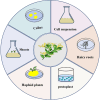Regulatory mechanisms and biosynthesis of chlorogenic acid in Lonicera japonica: insights from tissue culture and inducer treatments
- PMID: 40343127
- PMCID: PMC12058685
- DOI: 10.3389/fpls.2025.1567140
Regulatory mechanisms and biosynthesis of chlorogenic acid in Lonicera japonica: insights from tissue culture and inducer treatments
Abstract
Plant tissue culture is a fundamental and widely applied technique in plant biology and agriculture. In medicinal plant research, tissue culture plays an indispensable role in the conservation of endangered species, the rapid propagation of valuable resources, the preservation of germplasm, and the production of secondary metabolites. As a representative medicinal plant of the Lonicera genus, L. japonica is widely utilized worldwide due to its significant economic, ecological, medicinal, and ornamental value. By using tissue culture technology, it is possible to significantly enhance the production of secondary metabolites in L. japonica and effectively alleviate resource shortages, providing a new approach for its sustainable utilization. This review summarizes the recent research progress on L. japonica in the field of tissue culture, covering aspects such as direct organogenesis, indirect organogenesis through callus tissues, protoplast culture, hairy root culture, and polyploid culture. Additionally, the biosynthetic pathway of chlorogenic acid was explored in detail, and the mechanism of action of inducers in plant cells was analyzed. The study focused on the potential regulatory mechanisms of inducers on chlorogenic acid. Eventually, the future development trends of medicinal plant biotechnology are envisioned, aiming to provide a broader perspective for the in-depth study of medicinal plants and to promote continuous development and innovation in this field.
Keywords: L. japonica; chlorogenic acid; elicitors; synthetic biology; tissue culture.
Copyright © 2025 Cheng, Chen, Guo, Dong, Zhou, Liang and Wang.
Conflict of interest statement
The authors declare that the research was conducted in the absence of any commercial or financial relationships that could be constructed as a potential conflict of interest.
Figures






References
-
- Asyakina L., Sukhikh S., Ivanova S., Prosekov A., Ulrikh E., Chupahin E. (2021). Determination of the qualitative composition of biologically-active substances of extracts of in vitro callus, cell suspension, and root cultures of the medicinal plant Rhodiola rosea . Biomolecules 11, 365. doi: 10.3390/biom11030365 - DOI - PMC - PubMed
-
- Avila-Peltroche J., Won B. Y., Cho T. O. (2020). Optimization of protoplast isolation from the gametophytes of brown alga Undaria pinnatifida using response surface methodology. J. Appl. Phycol. 32, 2233–2244. doi: 10.1007/s10811-020-02095-3 - DOI
-
- Bhaskar R., Xavier L. S. E., Udayakumaran G., Kumar D. S., Venkatesh R., Nagella P. (2022). Biotic elicitors: A boon for the in-vitro production of plant secondary metabolites. Plant Cell Tiss. Organ. Cult. 149, 7–24. doi: 10.1007/s11240-021-02131-1 - DOI
Publication types
LinkOut - more resources
Full Text Sources
Research Materials

